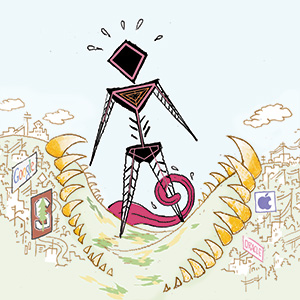Powdery, alkaline dust swirls in gusts that buffet tents, shade structures and towering sculptures. Inside one of the camps here, hands and legs grapple with touch screens affixed to a pole. Like an electronic game of Twister, the screens light up with colors, indicating where a person should next place a hand or foot. However, a cardboard-and-plastic spinner doesn’t randomly determine these moves; they’re modeled on choreography and programmed to display on the screens.
At Burning Man, the interactive game Pole Dance Revolution employed touch sensors several years before everyone began carrying around the technology—the user interface for smartphones—in their purses or pockets.
If electronics testing conjures up visions of bunny-suited workers and cleanrooms, the haphazard handling and dust, dry air and heat encountered on Burning Man’s dusty Playa offer, almost comically, the most extreme opposite.
And the harshness of Nevada’s Black Rock Desert, the site of the annual Burning Man celebration, provided a set of quite site-specific testing conditions.
“We learned things that really only apply in 40-mile-an-hour winds, with blowing dust,” says Ballistic, who worked on the mechanical engineering, software and sensors for Pole Dance Revolution—among many other projects. Ballistic, who chose to use his Playa name for this story, works for a company that creates touch sensors for consumer electronics. He says co-workers also contributed to Pole Dance Revolution.
Pelting dust is blessedly absent from most environments where one would use touch screens, but having to cope with the electrical charge that built up in the dry desert heat proved instructive for Ballistic and his co-workers.
“There were things that we learned about charging surfaces that affected the way we built touch screens and touch pads,” he says.
Whatever useful technological data can be gleaned from the Playa—or not—Burning Man, with its roots in the Bay Area and its maker culture, has become a valuable way for Silicon Valley’s tech community to connect.
Tesla co-founder Elon Musk has now famously conflated Burning Man and Silicon Valley. Talking to Re/code at an after-party for Mike Judge’s tech-skewering HBO sitcom Silicon Valley, Musk charged that Judge likely hadn’t ever gone to Burning Man, “which is Silicon Valley.” But Musk certainly has attended.
Such cachet was entirely absent in the early years, notes Giselle Bisson, a social media strategist and PR executive who has attended for 20 years (Bisson wrote an account of a trip to Burning Man—one of the first accounts—that was published by Metro in 1995). She has also served as a Burning Man camp co-founder and co-leader of three theme camps.
“It’s suddenly OK to go to Burning Man. It’s a status symbol to get to go there,” she says. But in the ’90s, it was considered “edgy, very dangerous.” One’s attendance was not information to be shared professionally.
Nowadays, she says it might compare to summer camp for adults. Some Burners create art projects before or during the festival. And just learning to create a semi-comfortable camp in the desert, like setting up a generator or building an outdoor solar shower, offers many useful lessons. Volunteering for camps can lead to a new skill set—Bisson says she initially learned social media skills marketing and promoting camps—or hone existing ones.
Carpenters may build something totally new for their camp, electricians may experiment with solar power, or engineers can play with new projects… continue reading



